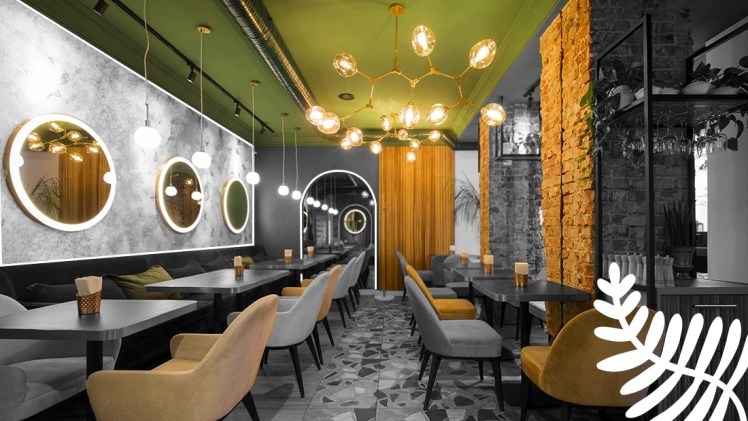The aesthetics and interior design of a restaurant attract guests while promising them a great culinary and sensory experience. The menu will always be your biggest asset but don’t underestimate the power of an exceptional design idea. Here are ten tips on how to design your own restaurant interior.
1. Have a Vision
The best way to start off is to make a vision board. Know exactly how you want your restaurant to look. Develop a concept, focus on a theme and match a style to your theme. To create the perfect look for your restaurant you have to know what you want to offer to your guests and how you would like to do so. Create an unforgettable sensory experience for your guests. The best way to this is to match your cuisine to the design of your restaurant.
2. Create a Layout Plan
The layout plan is essential to organizing your interior. It should include the location, the size and the setup of your furniture. Focus on clear paths for customers and servers and maximize every free space you have. The workflow should run smoothly. Make up your mind about the atmosphere you want to create and design a layout plan around that. Be clear about where and how you want to setup the kitchen, the bathrooms, tables and décor. It might be a smart choice to opt for a service that helps you create and design a layout plan. Hoga.Search offers the best interior design service for restaurants and hotels.
3. Eye-catching Entrance
First impressions matter. Use the theme you chose for your interior design and carry it through the entire establishment, even the exterior should give hints of the theme inside. The best way to attract customers is to have a welcoming restaurant with a clear indication as to what cuisine the restaurant serves. So, make sure possible customers see the outside of your restaurant and are clear about the experience you want to provide for them. The entrance should be unique and classy, but most importantly: inviting.
4. Décor
The element of décor and details will round up your interior design theme and concept. Take into account that you will want to choose painting, silverware, chairs, tables, stools and sculptures according to your theme. Also, make comfort a priority.
5. Use of Color
Choose your color palette wisely as it can influence your customer’s decision making and impacts the mood. Use colors to make your restaurant look spacious and bright. Also, coordinate the colors to your cuisine, theme and style you chose. Whereas red and yellow are strong stimulants, black and grey work the other way around. Milder stimulants are the colors green and teal as they remind us of healthy, low-processed food. Therefore, it is important to use color psychology to your advantage as it impacts appetite.
6. Use of Lighting
Lighting is an element you can use to alter your customers emotions and actions. Think about what kind of feeling you want to convey to your customers and choose suitbale lighting for that particular mood. Natural daylight feels the most comfortable to us. Therefore, it might be a smart decision to use daylight through big windows. To create a romantic atmosphere, it is best to use diffusing and ambient lighting. It also contributes to a cozy and intimate feeling. Many restaurants and bars choose low and dimmed lighting to create an intimate atmosphere. Therefore, your choice of lighting strongly depends on the theme and style of your restaurant and will enhance the overall experience of your customers. BUT: take into account that your customers have to be able to read the menu and your servers have to be able to see as they wait on said customers.
7. Seating
Use your seating arrangement to make your restaurant look lively and comfortable. A fine-dining experience will ask for luxurious tables and chairs. If you choose to integrate a bar to your restaurant, make sure the stools are comfortable and stylish as well. A simple café will ask for a different kind of seating arrangement. An innovative solution will attract more customers and enhance the dining experience. Always bear in mind to match your design ideas to your theme.
8. Kitchen Design
The kitchen is where the magic happens. Before deciding on what you want your kitchen to look like, make sure your kitchen layout works in your favor. Avoid slowing down your operation due to bad planning. The food has to flow seamlessly from the kitchen to the customer. Once you have figured out a way to perfect the workflow, concentrate on what kind of equipment you want to use. An open kitchen design is a contemporary and modern way to have food prepared and include your customer in the culinary experience. Opting for a traditional closed kitchen will bring a sense of calm to your restaurant. While planning your layout, it is important to mark different areas like the cooking and inventory area.
9. Acoustics
A way of attracting guests is through music and ambient noise. Well balanced acoustics, which means neither too loud nor too quiet surroundings, will have your customers feel comfortable and relaxed. A busy restaurant will make passersby curious and attract new potential customers, but too loud acoustics can interfere with conversation as your customers won’t be able to understand each other. Is your restaurant too quiet, it might make your guests feel uneasy. So, they way to go here is to aim for a well-balanced ambient background noise.
10. Scent
Just like colors, the catching scent of delicious food being prepared will influence your customer’s appetite and decision making. As an example, this is why bakeries display their freshly baked goods. The smell of pie and cookies is infatuating. The best way to use this to your advantage is to have an open or semi-open kitchen. It will spread the scent of your cuisine through your restaurant and catch people’s appetite.
Nothing stands in your way of designing a beautiful restaurant interior with these ten tips! Use all the mentioned elements as tools to create an inviting and comfortable atmosphere. Combining those with a delicious menu and great service, will provide you and your guests with an unforgettable dining experience.

